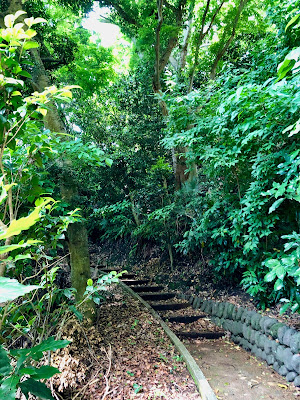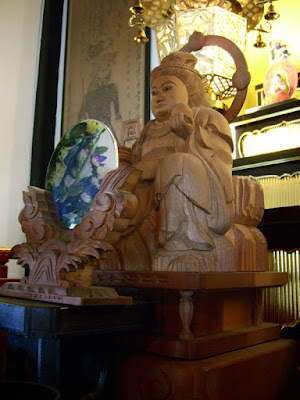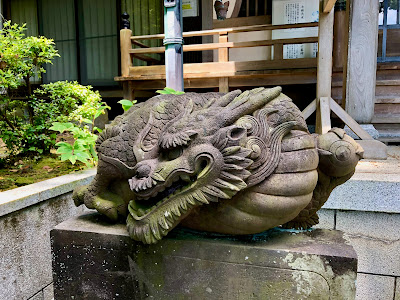目次 / Contents
1) 伝承と伝説 / Folklore and Legend
2) 仏舎利塔へ / To Stupa
A. 左の道 / Left Path
B. 七面堂 / Shichimen-do
a) 七面大明神 / Shichimen Daimyojin
b) 日蓮の伝説- 七面大明神
1) 伝承と伝説 / Folklore and Legend
本日、私と夫Rは、腰越の 'Art & Dining Spaceたぶのき' で開催されている絵本原画展が目的で外出しました。
龍口山 (リュウコウヤマ) にあります。
'龍口' : '龍ノ口' の由来は、'江島縁起' に代表される
鎌倉時代の僧、日蓮 (1222 - 1282) は、幕府によって、龍ノ口刑場で、斬首されそうになりますが、江ノ島からの光の玉 (球電) によって助けられる伝説 : 龍ノ口法難 (タツノクチホウナン)があります。
1337年に、日蓮の弟子・日法 (?-?) がこの地に、
敷皮石 (シキカワイシ) と自作の日蓮像を安置し敷皮堂というお堂を建立しました。
[敷皮石は、斬首されそうになった日蓮が座らせれた石です]
境内には、龍ノ口刑場跡、本堂、五重塔、
仏舎利塔 (ブッシャリトウ)、七面堂 (シメンドウ) などがあります。
このセクションは、主に七面堂についてです。
仁王門と龍ノ口刑場跡 については下記。
本殿周辺については下記。
 |
| 龍口寺境内 (Google Map) Ryūkō-ji Temple Precincts in Japanese 画像は下記より / This from below ★ |
Folklore and Legend
Today, I and my husband R went out for the purpose of the picture book original painting exhibition held in 'Art & Dining Space Tabunoki' in Koshigoe, Kamakura, Kanagawa prefecture.
Ryūkō-ji is a temple of the Nichiren Shū (Nichiren School / Nichiren sect) , located on Mt. Ryūkō.
'龍口' has pronunciation Ryūkō, Tatsunokuchi and another writing is 龍ノ口 : Tatsunokuci.
All mean 'dragon mouth'.
The origin of 'Ryūkō' is in the folklore of Benzaiten and
the five-headed dragon (Gozuryu) represented by 'Enoshima Engi'.
The five-headed dragon, who had been devouring children while storming the neighbourhood, was warned by Benzaiten, whom he fell in love with, and changed, reforming himself.
Tatsunokuchi was used as a place of execution from
the Kamakura period (1185 - 1333) to
the Muromachi period (1336 - 1573) and was called Tatsunokuchi Keijo.
Nichiren (1222 - 1282) was a Japanese Buddhist priest in
the Kamakura period who was about to be beheaded by the shogunate at the Tatsunokuchi execution site, but was saved by
a ball of light from Enoshima : Tatsunokuchi Persecution.
In 1337, a disciple of Nichiren, Nichipo (?-?), built a temple called Shikikawa-do on this site, enshrining a pavement stone : 'Shikikawaishi' and his own statue of Nichiren.
[The pavement stone is the stone on which Nichiren sat when he was about to be decapitated. ]
In the precincts, there are the Tatsunokuchi Persecution site, main hall, Japanese Five-storied Pagota, Shichimen-do Hall, stupa, etc.
This section is primarily about Shichimen-do Hall.
About Niōmon Gate and Tatsunokuchi execution site, below.
2) 仏舎利塔へ / To Stupa
A. 左の道 / Left Path
本堂左の赤い鳥居が並ぶ経八稲荷堂 (キョウハチイナリドウ) に興味をそそられて近づくと、その脇に龍口山へ登る道を見つけました。
経八稲荷堂については下記。
以前、瀧口寺を訪れたときは、本堂右の道を登り、五重塔を発見して喜びました。
左の道はどうなっているのかという好奇心があり登って行きました。
 |
| 赤い鳥居:経八稲荷堂 Red Torii Gate : Kyōhachiinari-do |
 |
| 何が先にあるか、そそられる道です。 It's an intriguing path to what lies ahead. |
Left Path
I was intrigued by Kyōhachi Inari-do Shrine with red torii gates on the left side of the main hall and found a path to climb Mt. Ryūkō on the side of the Inari-do Shiren.
About Kyōhachi Inari-do, below.
 |
龍口寺境内 Ryūkō-ji Temple Precincts in Japanese 画像は下記より / This from below |
 |
仏舎利塔と五重塔の案内板が七面倒前にあります。 There is an information board for the stupa (⬅︎) and the five-storied pagoda (➡︎) in front of Shichimen-do Hall. |
B. 七面堂 / Shichimen-do Hall
a) 七面大明神 / Shichimen Daimyojin
現在、日蓮宗の総本山は、山梨県にある
1282年日蓮は病死、彼の遺言により身延山に埋葬されました。歴代の住職により今日まで護られ続けています。
七面大明神 (シチメンダイミョウジン/ 七面天女) は、日蓮の伝説の
1つを由来 (b) の頃を参照)とし、久遠寺の守護神として信仰され、
日蓮宗が各地にひろまるとともに、日蓮宗寺院で祀られるようになりました。
日蓮宗としてはお寺としているのかもしれません。
龍口寺には、経八稲荷堂があり、七面大明神を祀る七面堂があり、
神仏習合 (シンブツシュウゴウ) を感じます。
私たちは、このことに慣れていて違和感を持ちませんが、一神教を信じる方々は随分とおかしな印象を持ちつのではないかと思います。
私は、懐の深い神仏習合は日本の誇るべき文化の1つではないかと思います。
 |
七面大明神 (七面天女) Shichimen Daimyojin (Shichimen Great Goddess / Shichimen Maiden) Shichimen Daimyojin Statue 画像は下記より / This from below |
Shichimen Daimyojin
Today, the head temple of the Nichiren Shū is
Minobusan・Kuon-ji Temple : ★ on Mt. Minobu in Yamanashi Prefecture.
Nichiren was exiled to Sado Province after the Tatsunokuchi Persecution, and returned to Kamakura in 1274 after being exiled.
Nanbu Sanenaga (1222 - 1297), a Jitō of Kai Province (Kai-no-kuni / present-day Yamanashi Prefecture) built the Kuon-ji Temple and invited Nichiren and donated the hall to him.
[Jitō (地頭) were medieval territory stewards in Japan, especially in the Kamakura and Muromachi shogunates.]
In 1282, Nichiren died of illness and was buried in Mt. Minobu according to his will.
His grave has been protected by successive chief priests to this day.Shichimen Daimyojin (Shichimen Great Goddess / Shichimen Maiden) is derived from one of the legends of Nichiren (See b) section), and was worshiped as the guardian deity of Kuon-ji Temple, after that, the Nichiren Shū spread to various places, and it came to be enshrined in Nichiren Shū temples.
As the Nichiren Shū spread throughout Japan, the Goddess came to be enshrined in Nichiren Shū temples.
The Goddess is enshrined in Keishin-in on the summit of Mt. Shichimen at an altitude of 1982m.
Keishin-in enshrines the Goddess, so I think it is a shrine, but it may be a temple for the Nichiren Shū.
Ryūkō-ji Temple has the Kyōhachi Inari-do Shine and the Shichimen-do Hall where the Shichimen Daimyojin is enshrined.
We are used to this and don't feel uncomfortable with it, but I think people who believe in monotheism have a very strange impression.
I think that deep-rooted syncretism of Shinto and Buddhism is one of the cultures that Japan should be proud of.
 |
山梨県 (甲斐国) / Yamanashi Prefecture 画像は下記より / This from below ★ |
b) 日蓮の伝説- 七面大明神
Legend of Nichiren - Shichimen Daimyojin
日蓮は、身延山で信者方に説法をしていました。
そのなかに身元がわからない女性が度々、姿を見せていました。
その情勢は、実は、龍の姿で七面山に住む七面大明神でした。
身延山の裏鬼門をおさえて、身延一帯を守っております。
末法の時代に、法華経を修め広める方々を末代まで守護し、その苦しみを除き心の安らぎと満足を与えます」
末法の時代に、法華経を修め広める方々を末代まで守護し、その苦しみを除き心の安らぎと満足を与えます」
そう言い終えるや否や、七面山山頂の方へと天高く飛んで行った。"
日蓮は、『いつか七面山に登って七面大明神を祀ろう』と考えていましたが、生きている間に叶いませんでした。
1297年、日朗は七面山に登り、祠を作り、七面大明神を祀ります。
これが七面山奥之院の開創で、現在では、敬慎院 (ケンシンイン) が本社となり、摂社として七面山奥之院があります。
これは、久遠寺の敬慎院または七面山奥之院からの勧請と考えられます。
 |
日本語版・久遠寺境内図 (拡大図: ★) 標高1153mの身延山は真ん中上です。 標高1989mの七面山は左上です。 Map of Kuon-ji Temple Precincts in Japanese (Enlarged View : ★) Mt. Minobu with an altitude of 1153m is the top middle. Mt. Shichimen : Shichimenzan, 1989m is on the upper left. 画像は下記より / This from below |
 |
英語版・久遠寺境内図 身延山は中心です。 七面山は左上です。 Map of Kuon-ji Temple Precincts in English Mt. Minobu is the center. Mt. Shichimen : Shichimenzan is on the upper left. 画像は下記より / This from below |
Nichiren was preaching to believers on Mt. Minobu.
Among them, a woman whose identity was unknown often showed up.
The stranger was actually Shichimen Daimyojin, who lives on Mt. Shichimen in the form of a dragon.
According to Japanese Wiki, (translated by me)
" 'I am Shichimen Daimyojin, who lives in Mt. Shichimen.
I hold the Ura-kimon : southwestern direction of Mt. Minobu and protect the Minobu area.
In the last world when the Buddha's teaching is obsolete, I will protect those who cultivate and spread the Lotus Sutra until the end of generations, and will relieve their suffering and give them peace of mind and satisfaction.'
As soon as the Goddess finished saying that, the Goddess flew high to the top of Mt. Shichimen. "
I hold the Ura-kimon : southwestern direction of Mt. Minobu and protect the Minobu area.
In the last world when the Buddha's teaching is obsolete, I will protect those who cultivate and spread the Lotus Sutra until the end of generations, and will relieve their suffering and give them peace of mind and satisfaction.'
As soon as the Goddess finished saying that, the Goddess flew high to the top of Mt. Shichimen. "
[According to the official website,
"Odaimoku is a special chant containing the complete title of the Lotus Sutra : Myoho Renge Kyo.
Chanting all the syllables of “Namu Myoho Renge Kyo” with absolute belief (Namu) in this supreme sutra is considered key to all merits given by Shakyamuni Buddha."]
Nichiren thought, "One day I will climb Mt. Shichimen and enshrine Shichimen Daimyojin,'' but it did not come true during his lifetime.
Nichiren's wish was granted by Nichiro (1245 - 1320), a leading disciple, one of the Six Major Disciples.In 1297, Nichiro climbed Mt. Shichimen, built a shrine, enshrining Shichimen Daimyojin.
This was the founding of Shichimenzan Oku-no-in, and today, Keishinin serves as the head office, and Shichimenzan Oku-no-in exists as a subsidiary shrine.
I think that the previous official website of Ryūkō-ji Temple said that 'the Shichimen-do of Ryūkō-ji was solicited from Kuonji Temple in the early Edo period'.
This is thought to have been solicited from Keishin-in of Kuon-ji Temple or Oku-no-in of Shichimenzan.
 |
"身延山久遠寺" (1930年) 川瀬 巴水 (カワセハスイ / 1883 -1957) 画 川瀬 巴水は、新版画を確立し 「旅情詩人」「旅の版画家」「昭和の広重」 などと呼ばれます。 国内よりもむしろ海外での評価が高いそうです。 私はこの版画家を初めて知りました。 "Mt. Minobu Kuon-ji Temple" (1930) By Hasui Kawase (1883 -1957) Hasui Kawase established Shin-Hanga : the new style of printmaking and has been called a "Poet of Travel", "Printmaker of Travel", and "Hiroshige of the Showa era". He seems to have a higher reputation overseas than at home. This is the first time I've heard of this printmaker. 画像は下記より / This from below |
 |
七面山・敬慎院 敬慎院は神社なのか、お寺なのか? 注連縄 (シメナワ) があるのですから神社でしょう? Keishin-in on Mt. Shichimen Keishin-in Shrine or Keishin-in Temple? There is a shimenawa, so it's a shrine, isn't it? Shimenawa are lengths of laid rice straw or hemp rope used for ritual purification in the Shinto religion. 画像は下記より / This from below |
 |
仏舎利塔方面へ 私たちは仏舎利塔を目指し、山を登ります。 心惹かれる雰囲気です。 Towards the Stupa We aim for the stupa and climb the mountain. The atmosphere is captivating. |



0 件のコメント:
コメントを投稿